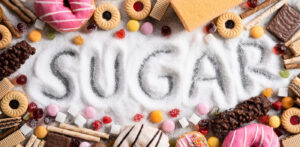Is Eating a High-Sugar Diet Killing Americans?

Most people have a sweet tooth because we all love to eat brownies, cookies, candy and ice cream. These foods are actually considered comfort foods in today’s world. Medical research has been suggesting for years, high sugar intake is the main culprit in increasing your risk of all of the killing diseases in America.
Medical Conditions and Diseases Caused by High Sugar Intake
- Weight Gain
- Increase Risk of Heart Disease
- Increase Risk of Type 2 Diabetes
- Increase Risk of Cancer
- Increase Risk of Fatty Liver
- Increase Risk of Depression
- Increase Risk of Kidney Disease
- Increase Risk of Developing Gout
- Accelerates Cognitive Decline: Dementia, Alzheimer’s Disease
- Negative Impact on Dental Health
- Accelerate Skin Aging and Cellular Aging
- Energy Draining
Deceptive Advertising Pushes Many Unhealthy Foods as Healthy Choices
Food lobbyists spend billions of dollars lobbying to Congress, FDA, CDC insisting some of their high sugar foods are very healthy to eat. They put deceptive ads on TV, radio, billboards, magazine advertising using deceptive advertising pushing the healthy aspects of some of the most unhealthy foods in the grocery store. Beware.


How Much Carbohydrate and Sugar Grams Should You Have Each Day?
The Dietary Guidelines for Americans recommend that carbohydrates make up 45% to 65% of total daily calories.
So if your caloric need is 2,000 calories a day, between 900 and 1,300 calories should be from carbohydrates. That translates to between 225 and 325 grams of carbs a day.
According to the USDA, on average, an American adult eats 17 teaspoons (68 grams) of added sugar per day. The 2020-2025 Dietary Guidelines for Americans, recommends limiting calories from added sugars to less than 10% per day.
The American Heart Association (AHA) suggests a stricter added-sugar limit of no more than 100 calories per day (about 6 teaspoons or 24 grams of sugar) for most adult women and no more than 150 calories per day (about 9 teaspoons or 36 grams of sugar) for most men.
What is the Difference Between Natural vs. Added Sugar
All sugars are carbohydrate. Carbohydrate is the body’s preferred source of energy. When you eat any carbohydrate, the body ultimately breaks the carbohydrate down into glucose. There are a number of different types of sugars.
Glucose: Glucose is a simple sugar that is the building block of carbohydrates.
Fructose: Fructose is another type of simple sugar found naturally in fruits, root vegetables and honey.
Sucrose: Sucrose is commonly known as table sugar. Sucrose includes equal parts of fructose and glucose.
Lactose: Lactose is the sugar that occurs naturally in milk. Lactose is made up of equal parts of glucose and galactose.
Sugar also occurs naturally in sugarcane and sugar beets as the sugar sucrose.
High fructose corn syrup (HFCS) is an added sugar made from corn. HFCS is the type of sweetener added to many soft drinks. HFCS-55 has 55% fructose and 45% glucose. HFCS-42 is used to sweeten baked goods and other beverages. HFCS-42 has 42% fructose and 58% glucose.
Even though honey, maple syrup and agave are natural sugars, for labeling purposes they are considered as added sugar to foods. In addition, sugar can also be processed into products like inverted sugar, corn syrup, dextrose, brown sugar, brown rice syrup, evaporated cane juice, molasses, etc. These are all considered added sugar.

Daily Carbohydrate Grams and Added Sugar Gram Allowance per Day
Daily Calories 45% CHO grams 65% CHO grams Added Sugar Grams*
1000 calories 112 grams 162 grams 25
1200 calories 135 grams 195 grams 30
1500 calories 168 grams 244 grams 38
1800 calories 202 grams 293 grams 45
2000 calories 225 grams 325 grams 50
2200 calories 247 grams 358 grams 55
*Added Sugar Grams per Day based on 10% of calories based on US Dietary Guidelines for Americans.
Use the Food Label to Determine Your Daily Sugar Intake

You can find the carbohydrate content of packaged foods on the Nutrition Facts label. The label shows total carbohydrates — which can include fiber, total sugars and added sugars. The Nutrition Facts Label will help you to determine how much sugar each package food contains. If a food contains 4 grams of total sugar like Heinz® Ketchup, today’s label will also spell out how many of those sugar grams are actually added sugar.
Keep in mind, fruits, vegetables and plain dairy products all contain natural sugar but if you add start adding ingredients like chocolate to milk, the added sugar grams will occur. The main sources of added sugar are desserts, soft drinks, sweetened dairy products like flavored milk, fruited and vanilla flavored yogurt, sweetened refined cereals like Fruit Loops, Lucky Charms, Apple Jacks.
Almost Everything Processed You Eat has Sugar
Example of some food items with the total sugar grams and added sugar.
Food Serving Total Sugar (g) Added Sugar (g)
Nekot® Peanut
Sandwich cookies 1 pack 12 grams 12 grams
Kind® Cranberry
Almond Bar 1 bar 8 grams 6 grams
Ragu® Chunky Garden
Combination Sauce ½ cup 10 grams 4 grams
Jif® Creamy
Peanut Butter 2 tablespoons 3 grams 2 grams
Sweet Baby Ray’s®
Barbecue Sauce 2 tablespoons 17 grams 2 grams
Heinz® Ketchup 1 tablespoon 4 grams 4 grams
Swapping Sugar for Healthier Lower Sugar Tips One Step at a Time
- Look for cereals, granola, and granola bars with under 4 grams of sugar.
- Sweeten plain yogurt with fresh or frozen berries instead of eating sugar-loaded yogurt.
- Make homemade fruit smoothies using plain yogurt and fresh or frozen fruits.
- Swap sugar-laden sodas, energy drinks, juices, sweetened teas with water with lemon or lime juice, unsweetened seltzer or low sugar flavoring drops.
- Replace candy with a homemade trail mix, nuts and a few dark chocolate chips.
- Choose lower sugar ketchup, marinades, marinara sauce, and spaghetti sauce or make your own.
- Choose low sugar jelly or put sliced bananas on your peanut butter sandwich.
- Drink alcohol beverages with low sugar mixers.
The Bottom Line
Added sugar has no nutritional value except calories. Even though when you eat any type of carbohydrate, the body breaks down into glucose which is used for energy, but too much added sugar over time will increase your risk of obesity, heart disease, metabolic syndrome, diabetes and cancer.
Sugar Image from: www.naturopathy-UK.com
![]()

By Barbara Day, M.S., R.D. is a registered dietitian with a Master’s Degree in clinical nutrition. She is the Chief Blog Organizer for www.DayByDayLiving.net
Barbara worked as a research nutritionist with the military’s tri-service medical school & working as a performance nutrition consultant to Navy SEALS’ BUD/S Training Program and West Coast active Navy SEAL Teams. Barbara is the former nutrition performance consultant to the University of Louisville Athletic Department. She is the author of Fast Facts on Fast Food For Fast People and High Energy Eating Sports Nutrition Workbook for Active People used by the University of Louisville, University of Tennessee Lady Vols and the Tennessee football program, the LSU basketball program, the Buffalo Bills, the Cleveland Browns and by the United States Navy SEALs.
The former publisher of Kentuckiana HealthFitness Magazine, Kentuckiana Healthy Woman magazine and radio show host of Health News You Can Use, Barbara has over 30 years of experience in promoting healthy lifestyles to consumers. Barbara is a former runner who walks, a spinner, hiker a mother and grandmother to 13 grandchildren.

